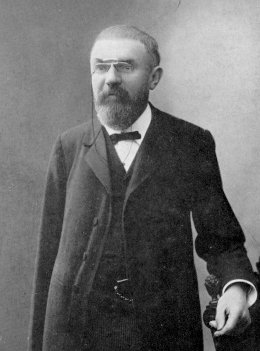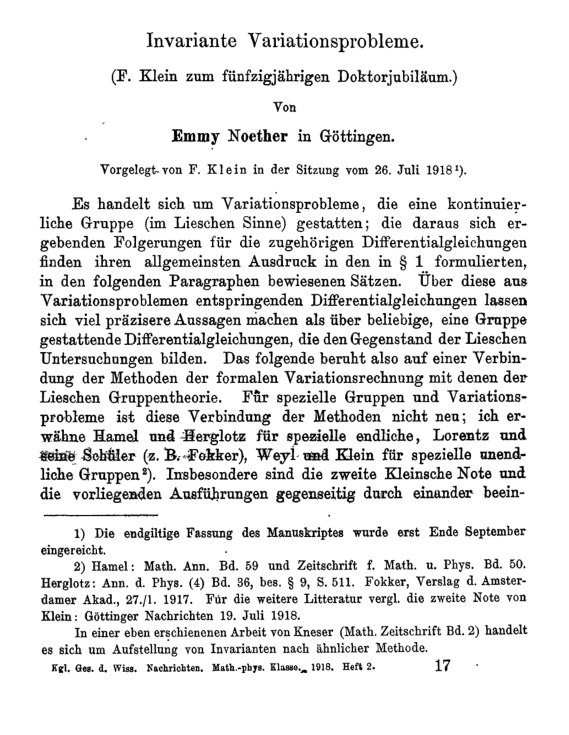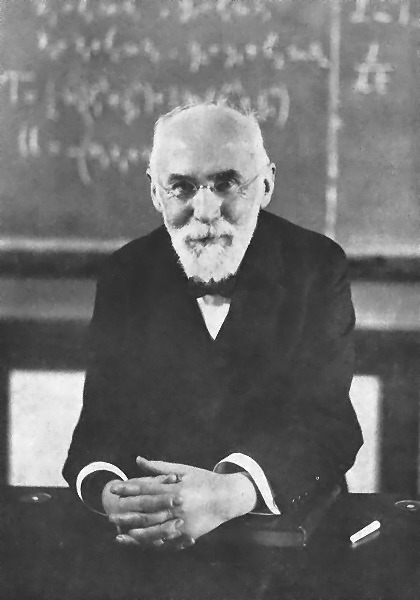|
Poincaré Group
The Poincaré group, named after Henri Poincaré (1906), was first defined by Hermann Minkowski (1908) as the group of Minkowski spacetime isometries. It is a ten-dimensional non-abelian Lie group that is of importance as a model in our understanding of the most basic fundamentals of physics. Overview A Minkowski spacetime isometry has the property that the interval between events is left invariant. For example, if everything were postponed by two hours, including the two events and the path you took to go from one to the other, then the time interval between the events recorded by a stop-watch you carried with you would be the same. Or if everything were shifted five kilometres to the west, or turned 60 degrees to the right, you would also see no change in the interval. It turns out that the proper length of an object is also unaffected by such a shift. A time or space reversal (a reflection) is also an isometry of this group. In Minkowski space (i.e. ignoring the effec ... [...More Info...] [...Related Items...] OR: [Wikipedia] [Google] [Baidu] |
Henri Poincare
Henri is an Estonian, Finnish, French, German and Luxembourgish form of the masculine given name Henry. People with this given name ; French noblemen :'' See the ' List of rulers named Henry' for Kings of France named Henri.'' * Henri I de Montmorency (1534–1614), Marshal and Constable of France * Henri I, Duke of Nemours (1572–1632), the son of Jacques of Savoy and Anna d'Este * Henri II, Duke of Nemours (1625–1659), the seventh Duc de Nemours * Henri, Count of Harcourt (1601–1666), French nobleman * Henri, Dauphin of Viennois (1296–1349), bishop of Metz * Henri de Gondi (other) * Henri de La Tour d'Auvergne, Duke of Bouillon (1555–1623), member of the powerful House of La Tour d'Auvergne * Henri Emmanuel Boileau, baron de Castelnau (1857–1923), French mountain climber * Henri, Grand Duke of Luxembourg (born 1955), the head of state of Luxembourg * Henri de Massue, Earl of Galway, French Huguenot soldier and diplomat, one of the principal commanders ... [...More Info...] [...Related Items...] OR: [Wikipedia] [Google] [Baidu] |
Galilean Group
In physics, a Galilean transformation is used to transform between the coordinates of two reference frames which differ only by constant relative motion within the constructs of Newtonian physics. These transformations together with spatial rotations and translations in space and time form the inhomogeneous Galilean group (assumed throughout below). Without the translations in space and time the group is the homogeneous Galilean group. The Galilean group is the group of motions of Galilean relativity acting on the four dimensions of space and time, forming the Galilean geometry. This is the passive transformation point of view. In special relativity the homogenous and inhomogenous Galilean transformations are, respectively, replaced by the Lorentz transformations and Poincaré transformations; conversely, the group contraction in the classical limit of Poincaré transformations yields Galilean transformations. The equations below are only physically valid in a Newtonian frame ... [...More Info...] [...Related Items...] OR: [Wikipedia] [Google] [Baidu] |
Compact Space
In mathematics, specifically general topology, compactness is a property that seeks to generalize the notion of a closed and bounded subset of Euclidean space by making precise the idea of a space having no "punctures" or "missing endpoints", i.e. that the space not exclude any ''limiting values'' of points. For example, the open interval (0,1) would not be compact because it excludes the limiting values of 0 and 1, whereas the closed interval ,1would be compact. Similarly, the space of rational numbers \mathbb is not compact, because it has infinitely many "punctures" corresponding to the irrational numbers, and the space of real numbers \mathbb is not compact either, because it excludes the two limiting values +\infty and -\infty. However, the ''extended'' real number line ''would'' be compact, since it contains both infinities. There are many ways to make this heuristic notion precise. These ways usually agree in a metric space, but may not be equivalent in other topo ... [...More Info...] [...Related Items...] OR: [Wikipedia] [Google] [Baidu] |
Isometry
In mathematics, an isometry (or congruence, or congruent transformation) is a distance-preserving transformation between metric spaces, usually assumed to be bijective. The word isometry is derived from the Ancient Greek: ἴσος ''isos'' meaning "equal", and μέτρον ''metron'' meaning "measure". Introduction Given a metric space (loosely, a set and a scheme for assigning distances between elements of the set), an isometry is a transformation which maps elements to the same or another metric space such that the distance between the image elements in the new metric space is equal to the distance between the elements in the original metric space. In a two-dimensional or three-dimensional Euclidean space, two geometric figures are congruent if they are related by an isometry; the isometry that relates them is either a rigid motion (translation or rotation), or a composition of a rigid motion and a reflection. Isometries are often used in constructions where one space ... [...More Info...] [...Related Items...] OR: [Wikipedia] [Google] [Baidu] |
Noether's Theorem
Noether's theorem or Noether's first theorem states that every differentiable symmetry of the action of a physical system with conservative forces has a corresponding conservation law. The theorem was proven by mathematician Emmy Noether in 1915 and published in 1918. The action of a physical system is the integral over time of a Lagrangian function, from which the system's behavior can be determined by the principle of least action. This theorem only applies to continuous and smooth symmetries over physical space. Noether's theorem is used in theoretical physics and the calculus of variations. It reveals the fundamental relation between the symmetries of a physical system and the conservation laws. It also made modern theoretical physicists much more focused on symmetries of physical systems. A generalization of the formulations on constants of motion in Lagrangian and Hamiltonian mechanics (developed in 1788 and 1833, respectively), it does not apply to systems that ... [...More Info...] [...Related Items...] OR: [Wikipedia] [Google] [Baidu] |
Semi-direct Product
In mathematics, specifically in group theory, the concept of a semidirect product is a generalization of a direct product. There are two closely related concepts of semidirect product: * an ''inner'' semidirect product is a particular way in which a group can be made up of two subgroups, one of which is a normal subgroup. * an ''outer'' semidirect product is a way to construct a new group from two given groups by using the Cartesian product as a set and a particular multiplication operation. As with direct products, there is a natural equivalence between inner and outer semidirect products, and both are commonly referred to simply as ''semidirect products''. For finite groups, the Schur–Zassenhaus theorem provides a sufficient condition for the existence of a decomposition as a semidirect product (also known as splitting extension). Inner semidirect product definitions Given a group with identity element , a subgroup , and a normal subgroup , the following stat ... [...More Info...] [...Related Items...] OR: [Wikipedia] [Google] [Baidu] |
Lorentz Invariance
In a relativistic theory of physics, a Lorentz scalar is an expression, formed from items of the theory, which evaluates to a scalar, invariant under any Lorentz transformation. A Lorentz scalar may be generated from e.g., the scalar product of vectors, or from contracting tensors of the theory. While the components of vectors and tensors are in general altered under Lorentz transformations, Lorentz scalars remain unchanged. A Lorentz scalar is not always immediately seen to be an invariant scalar in the mathematical sense, but the resulting scalar value is invariant under any basis transformation applied to the vector space, on which the considered theory is based. A simple Lorentz scalar in Minkowski spacetime is the ''spacetime distance'' ("length" of their difference) of two fixed events in spacetime. While the "position"-4-vectors of the events change between different inertial frames, their spacetime distance remains invariant under the corresponding Lorentz transformation ... [...More Info...] [...Related Items...] OR: [Wikipedia] [Google] [Baidu] |
Lorentz Group
In physics and mathematics, the Lorentz group is the group of all Lorentz transformations of Minkowski spacetime, the classical and quantum setting for all (non-gravitational) physical phenomena. The Lorentz group is named for the Dutch physicist Hendrik Lorentz. For example, the following laws, equations, and theories respect Lorentz symmetry: * The kinematical laws of special relativity * Maxwell's field equations in the theory of electromagnetism * The Dirac equation in the theory of the electron * The Standard Model of particle physics The Lorentz group expresses the fundamental symmetry of space and time of all known fundamental laws of nature. In small enough regions of spacetime where gravitational variances are negligible, physical laws are Lorentz invariant in the same manner as special relativity. Basic properties The Lorentz group is a subgroup of the Poincaré group—the group of all isometries of Minkowski spacetime. Lorentz transformations are, precisely, iso ... [...More Info...] [...Related Items...] OR: [Wikipedia] [Google] [Baidu] |
Three-dimensional Rotation
In mechanics and geometry, the 3D rotation group, often denoted SO(3), is the group of all rotations about the origin of three-dimensional Euclidean space \R^3 under the operation of composition. By definition, a rotation about the origin is a transformation that preserves the origin, Euclidean distance (so it is an isometry), and orientation (i.e., ''handedness'' of space). Composing two rotations results in another rotation, every rotation has a unique inverse rotation, and the identity map satisfies the definition of a rotation. Owing to the above properties (along composite rotations' associative property), the set of all rotations is a group under composition. Every non-trivial rotation is determined by its axis of rotation (a line through the origin) and its angle of rotation. Rotations are not commutative (for example, rotating ''R'' 90° in the x-y plane followed by ''S'' 90° in the y-z plane is not the same as ''S'' followed by ''R''), making the 3D rotation group a no ... [...More Info...] [...Related Items...] OR: [Wikipedia] [Google] [Baidu] |
Rotation
Rotation, or spin, is the circular movement of an object around a '' central axis''. A two-dimensional rotating object has only one possible central axis and can rotate in either a clockwise or counterclockwise direction. A three-dimensional object has an infinite number of possible central axes and rotational directions. If the rotation axis passes internally through the body's own center of mass, then the body is said to be ''autorotating'' or '' spinning'', and the surface intersection of the axis can be called a '' pole''. A rotation around a completely external axis, e.g. the planet Earth around the Sun, is called ''revolving'' or ''orbiting'', typically when it is produced by gravity, and the ends of the rotation axis can be called the '' orbital poles''. Mathematics Mathematically, a rotation is a rigid body movement which, unlike a translation, keeps a point fixed. This definition applies to rotations within both two and three dimensions (in a plane and in spa ... [...More Info...] [...Related Items...] OR: [Wikipedia] [Google] [Baidu] |
Abelian Group
In mathematics, an abelian group, also called a commutative group, is a group in which the result of applying the group operation to two group elements does not depend on the order in which they are written. That is, the group operation is commutative. With addition as an operation, the integers and the real numbers form abelian groups, and the concept of an abelian group may be viewed as a generalization of these examples. Abelian groups are named after early 19th century mathematician Niels Henrik Abel. The concept of an abelian group underlies many fundamental algebraic structures, such as fields, rings, vector spaces, and algebras. The theory of abelian groups is generally simpler than that of their non-abelian counterparts, and finite abelian groups are very well understood and fully classified. Definition An abelian group is a set A, together with an operation \cdot that combines any two elements a and b of A to form another element of A, denoted a \cdot b. The ... [...More Info...] [...Related Items...] OR: [Wikipedia] [Google] [Baidu] |
Translation (physics)
In Euclidean geometry, a translation is a geometric transformation that moves every point of a figure, shape or space by the same distance in a given direction. A translation can also be interpreted as the addition of a constant vector to every point, or as shifting the origin of the coordinate system. In a Euclidean space, any translation is an isometry. As a function If \mathbf is a fixed vector, known as the ''translation vector'', and \mathbf is the initial position of some object, then the translation function T_ will work as T_(\mathbf)=\mathbf+\mathbf. If T is a translation, then the image of a subset A under the function T is the translate of A by T . The translate of A by T_ is often written A+\mathbf . Horizontal and vertical translations In geometry, a vertical translation (also known as vertical shift) is a translation of a geometric object in a direction parallel to the vertical axis of the Cartesian coordinate system. Often, vertical translations a ... [...More Info...] [...Related Items...] OR: [Wikipedia] [Google] [Baidu] |



